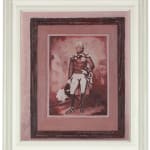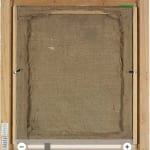

Keith Coventry
The Duke of York and Albany, 2004
oil on canvas, wood, gesso and glass
82.5 x 72.5cm
Copyright The Artist
Provenance
Private Collection.Haunch of Venison, London
Exhibitions
Glasgow, Tramway, Keith Coventry: Paintings, 2006 (installation view illustrated in colour, pp. 28 and 57).London, Haunch of Venison, Keith Coventry: Paintings and Sculpture Part II: Works 2002-2009, 2009, p. 181.
Woking, The Lightbox, Keith Coventry: Echoes of Albany, 2010
Literature
Christie's auction notes: The movement between what good taste deems desirable and that which should be hidden from sight is distilled though the lens of art history in Keith Coventry’s paintings. Putting formalist devices to work in the representation of contemporary society’s dirty secrets, Coventry creates erudite juxtapositions between lofty visions and debased realities. It is this penchant for poking fun at the rarefied seriousness of cultural hierarchies and peculiarly British traditions that made his inclusion in the seminal Sensation exhibition at the Royal Academy of Arts in 1997 so appropriate. Coventry’s ability to create paintings that address the history of picture making in the twentieth century with satirical wit is the definitive feature of his practice. His fluency in so many painterly languages, from the aesthetics of formal constructivism and Mondrian’s abstractions to his borrowing of fauvist flair or Sickert-esque description, allows him to use his means as an end, to turn stylization into subject matter.The Duke of York and Albany, Garden Bronze and Eagle 2 belong to Coventry’s series of forty-two works entitled Echoes of Albany, executed in 2004 and first exhibited at the artist’s mid-career retrospective at Tramway, Glasgow in 2006.
When Coventry took up residence in the Albany he joined as illustrious a roll-call of former residents as one could ever hope to compile. The exclusive collection of ‘sets’ that comprise the Albany mansions in London’s Piccadilly have been home to Byron and Gladstone, a broad sweep of the upper-most crust of the British aristocracy, assorted prime ministers and a litany of stars of stage and screen. However, on either side of the gilded corridor that bisects the private residencies of Albany, Coventry uncovered a history of libertinism and prurience in a tradition that parallels, and subverts, the respectable public face of the mansions. In their thickly dappled paint, subject matter and suggested narratives, the canvasses owe a debt to Walter Sickert’s own Echoes series, themselves a paean to the 19th century illustrator John Gilbert. The common thread that ties all three artists’ work together is the treatment of respectability and rakishness with equal measure, and in Coventry’s work at least, a celebration of the charm and contrariness of nostalgia.
Join our mailing list
* denotes required fields
We will process the personal data you have supplied in accordance with our privacy policy (available on request). You can unsubscribe or change your preferences at any time by clicking the link in our emails.

